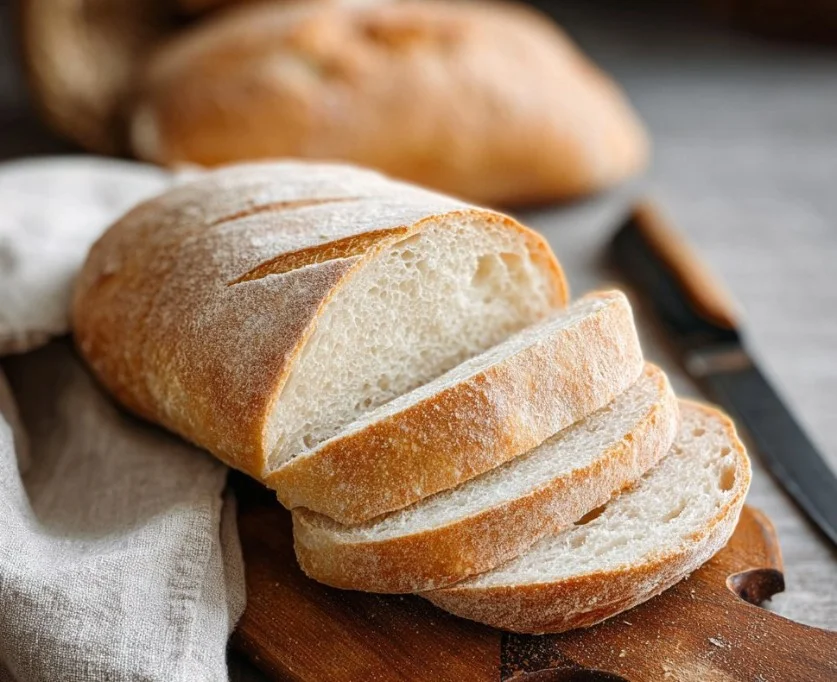Creating your own Italian Bread at home isn’t just about baking—it’s a celebration of flavors, a connection to traditions, and a way to make your meals more special. As you embark on this culinary adventure, you’ll discover that making Italian Bread is a straightforward process that leads to incredible results. The aroma of freshly baked bread wafting through your home is an experience like no other, offering a heartwarming embrace that reminds you of family gatherings and cozy dinners. This article will guide you through every step, ensuring that your baking experience is not only successful but also enjoyable.
Why We Love This Italian Bread Recipe
Italian Bread holds a unique place in many hearts (and stomachs). Its soft, chewy texture, paired with a perfectly crispy crust, creates a delightful contrast that’s hard to resist. You may love using this bread to accompany a rich pasta dish or dunking it into flavorful olive oil as an appetizer. It’s incredibly versatile, making it an essential staple in any kitchen.
Moreover, the process of making Italian Bread is gratifying. The simple ingredients come together to form something magnificent. Each knead and rise infuses a bit of love and care into the dough, creating a warm, comforting loaf that brings smiles to faces. There’s nothing like the satisfaction of slicing into a warm, golden loaf you created with your own hands. Whether it’s for a family meal, a gathering with friends, or just for yourself, this Italian Bread will undoubtedly elevate every dish it accompanies.
Ingredients for Italian Bread
To embark on this bread-making journey, you need a few key ingredients that you likely already have in your pantry. Each plays a crucial role in crafting this delightful loaf.
- 2 1/4 teaspoons active dry yeast
- 1 teaspoon granulated sugar
- 1 cup warm water (about 110°F)
- 2 1/2 cups bread flour or all-purpose flour
- 2 tablespoons olive oil
- 1 teaspoon salt
These ingredients come together to create a bread that is not only delicious but also simple to prepare. Make sure you’ve gathered everything before starting the process, as it will allow for a smoother baking experience.
How to Make Italian Bread Directions
Making Italian Bread may seem daunting at first, but once you dive into the process, you’ll find it to be quite simple. Follow these easy steps for a successful bake:
- Activate the Yeast: Begin by taking a large bowl and combining the active dry yeast, granulated sugar, and warm water. Stir gently to mix, then allow the mixture to stand for about 5 to 10 minutes until it becomes foamy. This step is crucial as it activates the yeast and helps your bread rise.
- Mix Ingredients: Next, add 2 cups of flour, 2 tablespoons of olive oil, and 1 teaspoon of salt to the bowl. Using a wooden spoon, stir the mixture until a shaggy dough begins to form. You want it to look sticky and messy at this point.
- Knead the Dough: Lightly flour a clean surface and turn out the dough. Knead it with your hands for about 10 minutes. You might find that you need to incorporate the remaining flour gradually until the dough becomes smooth and elastic. If you’re using a stand mixer, knead it on medium speed for about 5 minutes.
- First Rise: Shape the dough into a ball and place it in a bowl that you’ve lightly oiled. Turn the dough to coat it in oil, cover the bowl with a clean kitchen towel, and let it rise in a warm place for about an hour, or until it has doubled in size.
- Preheat Your Oven: While the dough rises, preheat your oven to 400°F (about 200°C). Line a baking sheet with parchment paper to ensure your bread doesn’t stick during baking.
- Shape the Dough: After the first rise, punch down the dough gently to release the air. Transfer the dough back to your floured surface and shape it into a 12-inch long batard (oval loaf). Carefully place it on the prepared baking sheet. Cover again and allow it to rise for another 20 to 30 minutes.
- Prepare for Baking: Just before your bread goes into the oven, use a sharp knife or a razor blade to make slits in the top of the dough. This helps the bread expand while it bakes.
- Bake: Place the baking sheet in the oven and bake for about 20 to 25 minutes, or until the loaf is golden brown and sounds hollow when tapped on the bottom.
- Cool: Once your bread is perfectly baked, remove it from the oven and transfer it to a wire rack. Allow it to cool completely before slicing. This might be the hardest step—waiting to taste that first slice!
As you slice into your freshly baked Italian Bread, take a moment to appreciate the texture and aroma before it disappears—trust us, it won’t last long!
How to Serve Italian Bread
Your Italian Bread is now baked to perfection, but how should you serve it? Here are some delightful ideas to maximize its enjoyment:
- With Olive Oil and Balsamic Vinegar: One of the most classic ways to enjoy Italian Bread is by serving it with high-quality olive oil and balsamic vinegar for dipping. A sprinkle of salt or a dash of pepper can elevate the flavors even further.
- As a Side Dish: Pair your warm bread with a variety of Italian dishes. Whether it accompanies a rich marinara pasta, a hearty soup, or even a fresh salad, the bread enhances the meal.
- Make Sandwiches: The crusty exterior and soft interior are perfect for creating delicious sandwiches. Fill your bread with slices of fresh vegetables, cheeses, and your choice of protein for a satisfying lunch.
- Toast: Slice your bread and pop it into a toaster or under the broiler for a little while. Top it with garlic butter, herbs, or even an avocado spread for a quick snack.
- Panzanella Salad: Transform leftover bread into a refreshing panzanella salad. Cube stale Italian Bread, toss it with fresh tomatoes, cucumbers, basil, olive oil, and vinegar for a summer favorite.
Each of these serving ideas can help you make the most of your Italian Bread, ensuring that every bite is packed with flavor.
Expert Tips: Italian Bread
To achieve the best results with your Italian Bread, consider these expert tips:
- Use the Right Flour: If you can, opt for bread flour. It has a higher protein content compared to all-purpose flour and will give your bread a better rise and chewier texture.
- Temperature of Water: Ensure your water is warm but not too hot or too cold. If it’s too hot, it can kill the yeast; if it’s too cold, the yeast won’t activate properly. Aim for about 110°F.
- Kneading Properly: Knead until the dough is smooth and elastic. This process develops the gluten, which is crucial for texture.
- Don’t Rush the Rise: Allow adequate time for rising. A longer rise at a cooler temperature can improve flavor, so if you have the time, consider letting the dough rise overnight in the refrigerator.
- Use Steam for a Crustier Crust: To achieve a beautifully crisp crust, place a shallow pan of hot water in the oven while your bread bakes. The steam produced will help create the crusty outside you desire.
With these tips in mind, you can perfect your Italian Bread and make it a staple in your culinary repertoire.
How to Store Italian Bread
Storing your homemade Italian Bread properly can prolong its freshness:
- Room Temperature: Once cooled, wrap the bread in a clean kitchen towel or place it in a bread box. This keeps the bread soft without trapping moisture that can make it soggy.
- Cutting Whole Loaves: If you have leftover bread, it’s best to keep the loaf whole. Slice it only when you’re ready to serve it. This way, the interior remains protected and fresh longer.
- Freezing: If you want to store bread for longer, you can freeze slices. Wrap them tightly in plastic wrap and place them in a freezer bag. When you need a slice, simply thaw it at room temperature or pop it in the toaster.
- Toast to Restore Freshness: If your bread becomes slightly stale, toasting it can revive its texture, allowing you to enjoy it once more.
By following these storage tips, you’ll ensure that your Italian Bread remains delightful for days or even weeks after baking.
Variations of Italian Bread
While the classic version of Italian Bread is heavenly, consider trying these variations to shake things up a bit:
- Herb-Infused Bread: Add herbs like rosemary or thyme to the dough before kneading. This infusion gives an aromatic twist and enhances flavor.
- Olive and Cheese: Incorporate pitted olives or cheese, such as mozzarella or Parmesan, into the bread dough. The melted cheese along with the fresh taste of olives creates a delightful combination.
- Garlic Bread: Make a variation by mixing garlic powder or fresh minced garlic into the dough. You can also top with garlic butter after baking for a cheesy garlic bread experience.
- Focaccia Style: Instead of shaping your dough into a loaf, try pressing it into a rectangular baking pan and adding toppings like rosemary, sea salt, and cherry tomatoes before baking to create a focaccia-style bread.
- Sweet Italian Bread: For a unique twist, you can create a sweet version by adding ingredients like cinnamon, raisins, or orange zest to the dough.
These variations not only keep your baking experience exciting but also allow you to explore a wider range of flavors and textures.
FAQ
What is the best flour for Italian Bread?
Bread flour is the best choice due to its higher protein content, which helps create a chewier texture. However, you can also use all-purpose flour if that’s what you have on hand.
Why is my Italian Bread dense?
If your bread turns out dense, it may be due to insufficient kneading or rising time. Ensure the yeast is active and that you’re allowing for enough rise before baking.
Can I make Italian Bread without a stand mixer?
Absolutely! Hand-kneading the dough will work just as well, although it may take a little more time and effort.
How do I know when the bread is done baking?
Your Italian Bread is ready when it turns a golden brown color and sounds hollow when tapped on the bottom. If you have a kitchen thermometer, the internal temperature should be around 190°F.
Can I add seeds on top of the bread?
Yes, sprinkling sesame or poppy seeds on top before baking can add interesting flavors and textures to your bread.

Italian Bread
Ingredients
Bread Ingredients
- 2 1/4 teaspoons active dry yeast Make sure the yeast is fresh for best results.
- 1 teaspoon granulated sugar Helps activate the yeast.
- 1 cup warm water About 110°F (43°C).
- 2 1/2 cups bread flour or all-purpose flour Bread flour is recommended for a chewier texture.
- 2 tablespoons olive oil For moisture and flavor.
- 1 teaspoon salt Enhances the flavor.
Instructions
Preparation
- In a large bowl, combine the active dry yeast, granulated sugar, and warm water. Stir gently and let it sit for 5-10 minutes until foamy.
- Add 2 cups of flour, olive oil, and salt to the bowl, stirring until a shaggy dough forms.
- Lightly flour a clean surface and knead the dough for about 10 minutes or until smooth and elastic. Alternatively, use a stand mixer on medium speed for about 5 minutes.
- Shape the dough into a ball and place it in a lightly oiled bowl. Cover with a kitchen towel and let it rise in a warm place for about 1 hour, or until doubled in size.
- Preheat the oven to 400°F (200°C) and line a baking sheet with parchment paper.
- Punch down the dough, shape it into a 12-inch long batard, and place it on the prepared baking sheet. Cover and let it rise for another 20-30 minutes.
- Before baking, use a sharp knife to make slits in the top of the dough.
- Bake for 20-25 minutes, or until golden brown and sounds hollow when tapped on the bottom.
- Remove from oven and transfer to a wire rack to cool completely before slicing.
Send me this recipe!
Just enter your email below and get it sent straight to your inbox!



